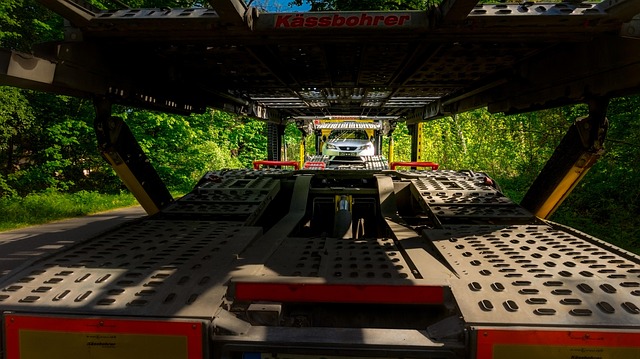Looking to register your car in California? This comprehensive guide will walk you through the process, ensuring a smooth experience. From understanding eligibility requirements to gathering essential documents, we cover it all. Learn how to perform a DMV VIN verification efficiently and navigate either the online or in-person registration process. Plus, discover the fees involved and get your license plate. Simplify car registration with our step-by-step instructions featuring key terms like ‘dmv vin verifier’.
- Understand Eligibility Requirements for Car Registration
- Gather Necessary Documents for Vehicle Registration
- Perform DMV Vehicle Identification Number (VIN) Verification
- Complete Online or In-Person Registration Process
- Pay Registration Fees and Receive Your License Plate
Understand Eligibility Requirements for Car Registration

Before you begin the registration process, it’s crucial to understand if your vehicle meets California’s eligibility criteria. The Department of Motor Vehicles (DMV) has specific requirements that all vehicles must fulfill before they can be registered. One essential step is ensuring the vehicle has a valid and accurate Vehicle Identification Number (VIN). A DMV VIN verifier or mobile VIN verifier can help you check and verify this critical information.
Additionally, your car must pass an emission test to ensure it complies with state pollution standards. This process typically involves inspecting the vehicle’s exhaust system and other environmental controls. A mobile VIN verification service can streamline this step by providing on-site inspections, making the registration process more convenient for California residents.
Gather Necessary Documents for Vehicle Registration

Before you start the registration process, make sure you have all the essential documents ready. The California Department of Motor Vehicles (DMV) requires a variety of paperwork to ensure a smooth and legitimate vehicle registration. One crucial document is the Vehicle Identification Number (VIN) verification report. You can obtain this through a DMV-approved mobile vin verifier or by visiting a local DMV office, where they provide mobile vin inspection services. This step is essential as it confirms your vehicle’s authenticity and history.
Additionally, gather other important documents like the title of ownership, which shows the previous owner and any transfers of ownership, proof of insurance, and possibly a completed application form for registration. It’s also beneficial to have a valid driver’s license and current vehicle registration (if applicable) from your previous state of residence. These mobile vin verification steps will help you navigate the registration process efficiently.
Perform DMV Vehicle Identification Number (VIN) Verification

Before registering your car in California, it’s crucial to have your Vehicle Identification Number (VIN) verified by the Department of Motor Vehicles (DMV). This process ensures that the vehicle is as described and helps prevent fraud. You can perform this verification in several ways, including using a mobile vin verifier or conducting a mobile vin inspection.
A mobile vin verifier is a convenient option where you can get instant results from anywhere. Simply enter your VIN into an approved app or website, and the system will cross-reference it with DMV records to confirm its authenticity. Alternatively, some services offer on-site mobile vin verification, which involves a trained professional visiting you to perform a physical inspection of the vehicle using the VIN. This method is beneficial for those who prefer a more traditional approach or have unique vehicles that require specialized attention.
Complete Online or In-Person Registration Process

Registering a car in California can be completed online or in-person at a DMV office. The process is straightforward and involves several key steps. For those who prefer a digital approach, completing the registration online offers a convenient and efficient method. Using the DMV’s official website, you can submit your application, upload necessary documents, and even pay the registration fees electronically. This option is ideal for folks with busy schedules or those who live far from a physical DMV location.
On the other hand, visiting a DMV office in person provides an alternative for those who prefer face-to-face interactions or need immediate assistance. At the DMV, you can fill out forms, present your required documents, and have them verified using a mobile vin verifier or traditional vin inspection. This ensures accuracy and helps avoid potential issues later on. Remember to bring your vehicle’s registration documents from the previous state, proof of insurance, and any other relevant paperwork to streamline the process.
Pay Registration Fees and Receive Your License Plate

After completing your vehicle’s registration application at the California DMV, it’s time to settle the fees. The amount varies based on your vehicle type and other factors, but you can expect to pay around $50 for most cars. You can usually pay online, by phone, or in person with a valid driver’s license and proof of insurance. Once your payment is processed, the DMV will issue your license plate, which typically features a unique combination of letters and numbers specific to your vehicle’s identification number (VIN).
For added convenience, many Californians opt for a mobile VIN verification service. This allows you to complete the license plate issuance process without visiting a DMV office. Using a mobile VIN inspection tool, you can quickly verify your car’s details online and even pre-order your plates before heading to the registration counter.
Registering a car in California is a straightforward process that requires understanding eligibility criteria, gathering essential documents, and completing either an online or in-person registration with the DMV. A key step involves using a dmv vin verifier to ensure vehicle identification number accuracy. Once approved, you’ll pay fees and receive your license plate, legally registering your vehicle for California roads.
